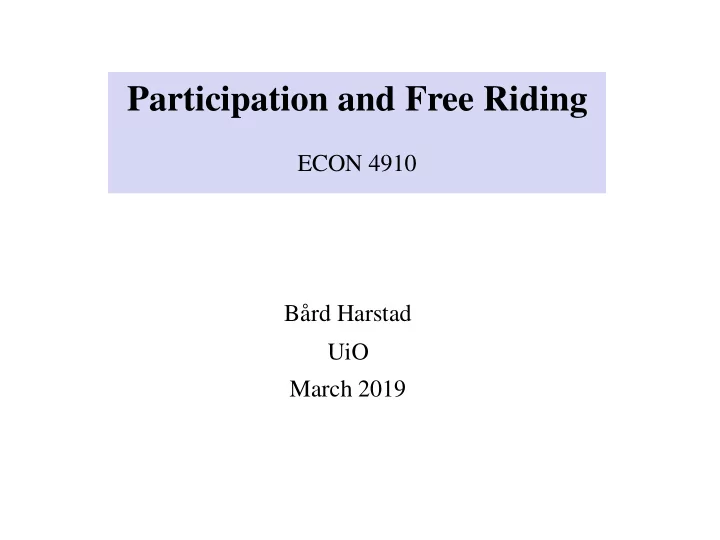

Participation and Free Riding ECON 4910 Bård Harstad UiO March 2019
Relationships 5y Duration 5% Emissions Technology NA Participation 37 (Kyoto)
Questions – and Preliminary Answers 1. Should one attempt to contract also on R&D? YES! (Last lecture, Buchholtz-Konrad, Beccherle-Tirole) 2. Is a long-term agreement better than a short-term one? YES! (Last lecture). 3. Is there a trade-off between width, depth, and length? YES (Barrett, Finus and Maus, Carraro, trade-literature) 4. Is the equilibrium coalition necessarily small? YES ( Barrett, Carraro-Siniscalco, Hoel, Dixit-Olson)
Assumptions (can be relaxed) 1. Countries are symmetric 2. Pollution is flow (stock depreciates after a period) 3. Technology depreciates after a period 4. Permits are non-tradable 5. Linear-quadratic utility functions
The “Standard” Participation Model The linear-quadratic model (Barrett ’05 for an overview): b 2 ( ) , 1 ,..., B g y g i N n Benefit , , i t i t 2 u B g C g Costs , , , i t i t i t i N Timing: (1) Participate, (2) pollute. Internal stability: No participation should want to leave External stability: No free-rider should want to join
A Dynamic Model: Timing g i,t+1 g i,t r i,t r i,t+1 Time τ ∆ Period
Model: Equations A linear-quadratic model: b 2 ( ) , 1 ,..., B y y y i N n Benefit i , t i , t 2 g y r Emission i , t i , t i , t k 2 u B y C g r Utility i , t i , t i , t i , t 1 i N 2 e ( ) k e k k e k Equilibria: Markov-perfect
Preliminaries Preferences rewritten. If: d y y g y d r i , t i , t i , t i , t i , t ˆ t 1 , v u where i , 1 i , t 1 t b k ˆ 2 2 u d C y d r r , , , , 1 , 1 i t i t j t j t i t 2 j N 2 So, no past action is «payoff relevant» … except whether commitments have been made … => Simple to use Markov-perfect equilibria
First Best Business as Usual Concave&symmetric welfare f. If nothing is contractible C C r r n i , t i , t k k C C d d n , i t i , t b b C C C C g y n n g y , i t i , t k b k b d k d k , i t i , t x x r b r b , i t i , t Nonparticipants always act this way
Incomplete Contracts Complete Contracts b y g C Depth: for a given m and T… , i t , r t T, r 1 i , t i , T b k k C C C r m g y m m i , t i , t k k b C C C d m r m r , , , 1 i t i t i T b k k C C C g y m m d m , , i t i t k b b d d k k , , i t i t x x r b r b , , i t i t ˆ Length: if T m m m if T m m m m ˆ 1 if T m m m 1 if T m m m m Width: m * = {2,3} Larger; m*=n possible
Intuition ⇒ T = ∞ ⇒ r = m(C/k) Participate? m = m* 2 3 if x ≽ * x m m IFF I if x ⇒ T = 1 ⇒ r = C/k Deviate? m = m*-1 ˆ * 1 * , IFF m m m m where M 1 1 . m M x 1 1 x Proposition: m* is an equilibrium iff: * = n → FB iff δ↑ and x moderate min , , m m m n I M
The key variable is: x=k/b 12
Bottom line The hold-up problem can be beneficial and a credible out-of-equilibrium threat, materialized if a participant deviates, investments are noncontractible, and T is endogenous
Participation: Lessons 1. If countries can opt out, there is a strong incentive to free-ride 2. In static linear-quadratic models, only 3 (!) countries want to participate in equilibrium 3. This conclusion continues to hold even if we add: a) Green technology or b) Many periods 4. But the coalition can be much larger if: a) Contracts are incomplete and b) Duration is endogenous 5. The hold-up problem can then be beneficial : it is materialized only if few countries participate, since only a large coalition prefers to lock in the participants, and this (credible) threat can motivate many more countries to participate. 6. There are thus also good equilibria in Kyoto-style games where countries negotiate emissions, but not investments.
Dynamic Games in Environmental Economics Lessons Emissions Investments 1. Recent theory on repeated games, dynamic games, and contract theory can be used to analyze environmental issues. 2. In business as usual, countries may invest strategically little, to motivate others to invest more and pollute less later. 3. In repeated games, countries may want to require over- investments in technology to ensure compliance. 4. With commitments, emission quotas should be small to motivate investments. 5. Investments will be strategically small before bargaining 6. This can make short-term agreements costly. 7. Only a large coalition prefers to lock in for the long run. 8. This can motivate free-riders to participate.
Recommend
More recommend